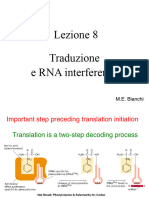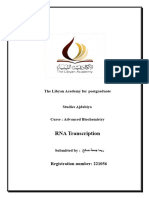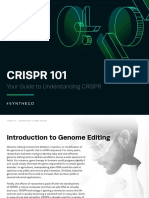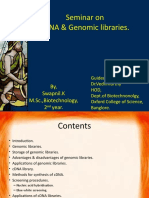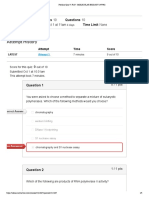0 ratings0% found this document useful (0 votes)
5 viewsUNIT 3 - Transcription
UNIT 3 - Transcription
Uploaded by
Muralidharan MCopyright:
© All Rights Reserved
Available Formats
Download as PDF, TXT or read online from Scribd
UNIT 3 - Transcription
UNIT 3 - Transcription
Uploaded by
Muralidharan M0 ratings0% found this document useful (0 votes)
5 views1 pageOriginal Title
UNIT 3_transcription
Copyright
© © All Rights Reserved
Available Formats
PDF, TXT or read online from Scribd
Share this document
Did you find this document useful?
Is this content inappropriate?
Copyright:
© All Rights Reserved
Available Formats
Download as PDF, TXT or read online from Scribd
Download as pdf or txt
0 ratings0% found this document useful (0 votes)
5 views1 pageUNIT 3 - Transcription
UNIT 3 - Transcription
Uploaded by
Muralidharan MCopyright:
© All Rights Reserved
Available Formats
Download as PDF, TXT or read online from Scribd
Download as pdf or txt
You are on page 1of 1
RNA SYNTHESIS: INITIATION, ELONGATION, TERMINATION OF RNA SYNTHESIS
Jayapriya K, Deepika S, Abitha A, Abinaya J, Akshaya V, Dr.Muralidharan M*
B.TECH. BIOTECHNOLOGY, Gnanamani College of Technology, Molecular Biology, Batch:2022-2026
*Assistant Professor, Department of Biotechnology, Gnanamani College of Technology
DEFINITION: Transcription is the essential biological process by which genetic information encoded in double-stranded DNA is transcribed into a single-stranded RNA molecule. This process is catalyzed by the enzyme RNA polymerase.
During transcription, the DNA strand that serves as the template is known as the template strand or antisense strand. This strand runs in the 3’ to 5’ direction, and it provides the sequence from which the RNA is synthesized in the 5’ to 3’
direction. The complementary DNA strand, which has a sequence identical to the RNA (except for the replacement of thymine with uracil), is called the coding strand or sense strand.
STAGES IN TRANSCRIPTION: EUKARYOTIC TRANSCRIPTION
TRANSCRIPTION Occurs in the nucleus. There
UNIT
PROMOTER TERMINATOR are three main types of RNA
5’ 3’ polymerases involved, each
3’ 5’ responsible for synthesizing
DNA
RNA Binding of RNA Polymerase different types of RNA.
Polymerase to the promoter region •RNA Polymerase I: most of rRNA, except for the 5S rRNA.
causes DNA unwinding •RNA Polymerase II: mRNA and RNA (snRNA).
5’ ’
3
3’ 5’ •RNA Polymerase III: tRNA , 5S rRNA.
UNWOUND RNA is synthesized by adding
DNA NTPs
the nucleotides complementary TERMINATION STAGE
CODING
to the DNA template General transcription factors and RNA
STRAND
5’ 3’ polymerase initiate transcription.
3’ 3’ 5’ 1. Initiation • TFIID binds to the TATA box.
5’ RNA polymerase synthesizes
TEMPLATE NTPs Promoter Recognition: Transcription starts when RNA polymerase binds to a specific DNA • TFIIA and TFIIB bind subsequently.
STRAND RNA by moving along the DNA sequence known as the promoter. In prokaryotes, RNA polymerase directly binds to the • The complex binds to RNA polymerase, with
template in the 5’ to 3’ direction promoter with the help of a sigma factor. In eukaryotes, a complex of transcription
TFIIF aiding RNA polymerase binding to DNA.
3’
5’
’
factors assists RNA polymerase II in locating the promoter. • Addition of TFIIE, TFIIJ, and TFIIH (which has
3’ ’
3 Elongation involves 5
5 ’ DNA Unwinding: The DNA double helix unwinds near the promoter, creating a helicase activity) completes the initiation
RNA
NTPs continuous reading of DNA transcription bubble that allows RNA polymerase to access the template strand. complex.
template and extension of • The initiation complex is activated by the ATP-
2. Elongation
5’ RNA molecule 3 ’
dependent phosphorylation of the C-terminal
3’
5 ’ RNA Synthesis: RNA polymerase travels along the DNA template strand, synthesizing RNA
3’
5’
domain (CTD) of RNA polymerase II. This
by adding ribonucleotides complementary to the DNA template. The RNA strand grows in
Termination occurs when RNA phosphorylation, primarily mediated by TFIIH,
RNA the 5’ to 3’ direction.
POLYMERASE polymerase reaches a triggers a conformational change in RNA
5’ terminator sequence 3’ 3. Termination polymerase II, enabling it to start RNA
3’ 5’ Signal Detection and RNA Release: Transcription stops when RNA polymerase reaches a synthesis.
’
+ terminator sequence in prokaryotes or a polyadenylation signal in eukaryotes. The newly ELONGATION STAGE:
5 3’
RNA TRANSCRIPT synthesized RNA transcript is then released. • RNA polymerase II, with the help of elongation factors and carboxy-
RNA Processing (Eukaryotes): In eukaryotes, the initial RNA (pre-mRNA) undergoes terminal domain (CTD) phosphorylation, synthesizes RNA while
processing, including capping, polyadenylation, and splicing, to form mature mRNA ready navigating chromatin. Eukaryotic DNA is packed in chromatin,
Three Stages: Initiation Elongation Termination for translation.
necessitating remodeling to enable transcription. The RNA undergoes
co-transcriptional processing, including 5’ capping, splicing, and
PROKARYOTIC TRANSCRIPTION TERMINATION STAGE: polyadenylation.
It occurs in the cytoplasm. A single RNA Rho independent termination TERMINATION STAGE:
• The newly formed RNA has GC rich
polymerase is used to synthesis all three • During termination, RNA polymerase II
types of RNA. sequence followed by poly U
sequence. transcribes a polyadenylation signal,
• GC rich sequence (inverted leading to RNA cleavage and the addition
sequence) form hairpin loop which of a poly(A) tail. The newly synthesized
pulls RNA chain and weak bond mRNA includes coding regions (exons) and
between A=U are broken and non-coding regions (introns).
released. • For the mRNA to be functional, introns
-35 box and -10 box (also called Pribnow
Rho dependent termination • Rho factors /proteins causes must be removed and modifications such
box) are consensus sequences.
disruption of RNA-DNA hybrid as a 5’ cap and 3’ poly-A tail are added. This
• Rho protein is a specialized process, known as splicing, is performed by
helicase, which recognizes a complex called the spliceosome, which
ELONGATION STAGE: terminator region in mRNA
The RNA polymerase slides along the template removes introns and joins exons to produce
sequence.
DNA strand (in the 3’-5’ direction). The a mature mRNA strand. The mature mRNA
• Rho protein releases newly
transcription elongation phase beings with the can then leave the nucleus and enter the
formed RNA.
release of the sigma subunit from the polymerase. cytoplasm for translation.
You might also like
- Worksheet - DNA Strucuture and ReplicationDocument4 pagesWorksheet - DNA Strucuture and ReplicationKittikorn HongyimNo ratings yet
- PROTEIN SynthesisDocument37 pagesPROTEIN SynthesisChirag Kothari100% (1)
- Gene Expression - Protein SynthesisDocument39 pagesGene Expression - Protein SynthesisTawonga ManjiniNo ratings yet
- From Gene To ProteinDocument42 pagesFrom Gene To ProteinNathan AdornadoNo ratings yet
- Fenomena Biomedik Dari Transkripsi Gen Hingga MetabolismeDocument45 pagesFenomena Biomedik Dari Transkripsi Gen Hingga MetabolismeratuurizkyNo ratings yet
- The Central Dogma of Life.: ReplicationDocument82 pagesThe Central Dogma of Life.: ReplicationVictor YandilaNo ratings yet
- Lecture 4 - Mechanism of Transcription in BacteriaDocument51 pagesLecture 4 - Mechanism of Transcription in BacteriaBakalJenazahNo ratings yet
- Chapter 15 BIO 1510Document34 pagesChapter 15 BIO 1510Chachi CNo ratings yet
- 8c) Transcription Summary - 9744 - 2018Document1 page8c) Transcription Summary - 9744 - 20182022 EMMA WEN XUAN HANSONNo ratings yet
- DNA To RNA To Protein-66587207Document40 pagesDNA To RNA To Protein-66587207Abdo HusseinNo ratings yet
- TranscriptionDocument75 pagesTranscriptionspitzmark2030No ratings yet
- 3rd Week (1) - TrancriptionDocument46 pages3rd Week (1) - TrancriptionyazicigaamzeNo ratings yet
- The Molecule of Life Is Transmitted and ExpressedDocument51 pagesThe Molecule of Life Is Transmitted and ExpressedAlkhair SangcopanNo ratings yet
- S2. Transcription Translation Gene RegulationDocument87 pagesS2. Transcription Translation Gene RegulationDeriq Maorenz CruzNo ratings yet
- Lesson 0.1 From Gene To ProteinDocument77 pagesLesson 0.1 From Gene To Proteinandreideleon51No ratings yet
- Answers To Cycle 7 Activities 2024-1Document7 pagesAnswers To Cycle 7 Activities 2024-1codic95220No ratings yet
- Transcription_FinalDocument21 pagesTranscription_FinalanujsNo ratings yet
- Protein Synthesis - DNA Transcription and Translation-2Document51 pagesProtein Synthesis - DNA Transcription and Translation-2limshinyen22No ratings yet
- 3- Cap 12 Transcription -Prof CANDI 2022-2023Document39 pages3- Cap 12 Transcription -Prof CANDI 2022-2023diana LightNo ratings yet
- Biomol R2 Kurniahtunnisa 0402517015 RefleksiDocument15 pagesBiomol R2 Kurniahtunnisa 0402517015 RefleksiKurniah TunnisaNo ratings yet
- Transcription and TranslationDocument8 pagesTranscription and Translationgwentoledo33No ratings yet
- Transcription: DR Vaishali Dhat Professor, Department of Biochemistry DR DypmcDocument25 pagesTranscription: DR Vaishali Dhat Professor, Department of Biochemistry DR Dypmcnishkarsh chauhanNo ratings yet
- READING ESSENTIALS Chap 12 DNA RNA and ProteinDocument8 pagesREADING ESSENTIALS Chap 12 DNA RNA and ProteinthecarrotstringNo ratings yet
- Science of Living System: Nihar Ranjan JanaDocument20 pagesScience of Living System: Nihar Ranjan JanaRajnandni SharmaNo ratings yet
- 11 Chapter 5Document38 pages11 Chapter 5toobashafiNo ratings yet
- Translation: The Systhesis of A Polypeptide ChainDocument3 pagesTranslation: The Systhesis of A Polypeptide ChainAizat HakimieNo ratings yet
- 2018 - Lecture 4-5-CanvasDocument76 pages2018 - Lecture 4-5-CanvasAdam Bryant PoonawalaNo ratings yet
- Mrs. Ofelia Solano Saludar: Department of Natural Sciences University of St. La Salle Bacolod CityDocument55 pagesMrs. Ofelia Solano Saludar: Department of Natural Sciences University of St. La Salle Bacolod CitymskikiNo ratings yet
- M.I.T LessonsDocument12 pagesM.I.T LessonsChassy KammyNo ratings yet
- RNA - Polymerase 1 ClassDocument21 pagesRNA - Polymerase 1 ClassSeemaNo ratings yet
- Transcription and TranslationDocument35 pagesTranscription and TranslationMing mingNo ratings yet
- Mol. Basis Cheat SheetDocument3 pagesMol. Basis Cheat SheetShradha SharmaNo ratings yet
- Unit-3 Transcription in Eukaryotes-IDocument14 pagesUnit-3 Transcription in Eukaryotes-IRickySaptarshi SahaNo ratings yet
- MOL 125 Lecture 5&6 RNA Transcription: Lippincott's Illustrated Reviews: Cell and Molecular Biology, DR Hanaa HajeerDocument52 pagesMOL 125 Lecture 5&6 RNA Transcription: Lippincott's Illustrated Reviews: Cell and Molecular Biology, DR Hanaa HajeerAffan Elahi100% (1)
- Transcription & Translation Notes PDFDocument20 pagesTranscription & Translation Notes PDFManas RjNo ratings yet
- 27. Transcription IIIDocument15 pages27. Transcription IIImahekshaikhdxbNo ratings yet
- TranscriptionDocument31 pagesTranscriptionDeeptanshu PrakashNo ratings yet
- Lez08 Traduz RnaDocument47 pagesLez08 Traduz RnaMaria HuNo ratings yet
- Everse Ranscriptase: RT-PCR R T PCRDocument11 pagesEverse Ranscriptase: RT-PCR R T PCRapi-19916399No ratings yet
- RNA TranscriptionDocument7 pagesRNA Transcriptionshereefadoma96No ratings yet
- Transcription 2Document66 pagesTranscription 2Safe BoxNo ratings yet
- Ribonucleic Acid2Document39 pagesRibonucleic Acid2Kawalya stevenNo ratings yet
- Protein Synthesis: ADA School Biology DepartmentDocument27 pagesProtein Synthesis: ADA School Biology DepartmentAydan BadalliNo ratings yet
- Key Notes Genetic Material and Central DogmaDocument2 pagesKey Notes Genetic Material and Central DogmaSeiza WinchesterNo ratings yet
- Nucleic Acid Metabolism TAUDocument38 pagesNucleic Acid Metabolism TAUFaatimah EssaNo ratings yet
- VSU-2020-PPT Information Transfer Protein SynthesisDocument78 pagesVSU-2020-PPT Information Transfer Protein SynthesisAndreah BaylonNo ratings yet
- Transcription and RNA ProcessingDocument38 pagesTranscription and RNA ProcessingRishi Kumar100% (1)
- Transcription, PTMDocument91 pagesTranscription, PTMnikhilsathwikNo ratings yet
- TranscriptionDocument15 pagesTranscriptioncamila hartmannNo ratings yet
- (L-8) - Molecular Basis of Inheritance - Feb 1, 2020Document48 pages(L-8) - Molecular Basis of Inheritance - Feb 1, 2020AyazNo ratings yet
- Gene ExpressionDocument46 pagesGene Expressionmohammed mahmoudNo ratings yet
- RNA Synthesis and Gene Control in ProksDocument41 pagesRNA Synthesis and Gene Control in ProksnkolenowellNo ratings yet
- Bm101: Biology For Engineers: Instructor: Yashveer Singh, PHDDocument15 pagesBm101: Biology For Engineers: Instructor: Yashveer Singh, PHDhimanshu singhNo ratings yet
- Dna TranscriptonDocument26 pagesDna TranscriptonJesse Kate GonzalesNo ratings yet
- 5 11transcription-2013Document30 pages5 11transcription-2013jernsssNo ratings yet
- RNA Synthesis and ProcessingDocument17 pagesRNA Synthesis and ProcessingInnocent Clifford MaranduNo ratings yet
- Gene Expression - Group 1 (Roll No 1 - 23)Document34 pagesGene Expression - Group 1 (Roll No 1 - 23)Kaung Wai Yan HeinNo ratings yet
- Lecture 13 Genes and How They WorkDocument31 pagesLecture 13 Genes and How They WorkPaulNo ratings yet
- Molecular Genetics: RNA and Transcription: Reading: Chapter 15Document32 pagesMolecular Genetics: RNA and Transcription: Reading: Chapter 15zeinamakNo ratings yet
- Synthego Ebook Crispr 101 PDFDocument29 pagesSynthego Ebook Crispr 101 PDFRie R100% (1)
- DNA Fingerprinting: (Notes)Document10 pagesDNA Fingerprinting: (Notes)Nelson LaishramNo ratings yet
- Primer Design Using IDT Quest: Identifying NCBI Transcript & Associated PrimersDocument3 pagesPrimer Design Using IDT Quest: Identifying NCBI Transcript & Associated PrimersAqsa MuzammilNo ratings yet
- 3.2.5 Practice - From Nucleic Acids To Proteins (Practice)Document8 pages3.2.5 Practice - From Nucleic Acids To Proteins (Practice)bushraNo ratings yet
- Kirk Polka - Genetic Code WorksheetsDocument3 pagesKirk Polka - Genetic Code WorksheetsKirk PolkaNo ratings yet
- Learning Unit 3 - PART 2 - DNA ReplicationDocument43 pagesLearning Unit 3 - PART 2 - DNA ReplicationSphesihle ThekoNo ratings yet
- Equipe1 - A Tale of Three Next Generation Sequencing Platforms - Comparison of Ion Torrent, Pacific Biosciences and Illumina MiSeq SequencersDocument13 pagesEquipe1 - A Tale of Three Next Generation Sequencing Platforms - Comparison of Ion Torrent, Pacific Biosciences and Illumina MiSeq SequencersFagnerOliveiraNo ratings yet
- Peptide Nucleic AcidDocument27 pagesPeptide Nucleic AcidDharmendra KumarNo ratings yet
- Process - Nucleic AcidsDocument3 pagesProcess - Nucleic AcidsBea BalaoroNo ratings yet
- Mutations Worksheet PDFDocument2 pagesMutations Worksheet PDFNouradin Ibrahim OmerNo ratings yet
- PrimersDocument7 pagesPrimersh gNo ratings yet
- Druid Dracula - Post Case QuestionsDocument7 pagesDruid Dracula - Post Case QuestionsKory TurnerNo ratings yet
- Dna Repair Lehninger Principles of Biochemistry (5E 2008 ISBN 9780716771081) David L. Nelson, Michael M. CoxDocument11 pagesDna Repair Lehninger Principles of Biochemistry (5E 2008 ISBN 9780716771081) David L. Nelson, Michael M. CoxneharikagartiaNo ratings yet
- BIOC15 Class 20 NotesDocument9 pagesBIOC15 Class 20 NotesCindy HouNo ratings yet
- Genomic and cDNA LibrariesDocument26 pagesGenomic and cDNA LibrariesSwapnil Kaldhone100% (1)
- Real Time PCR Handbook PDFDocument73 pagesReal Time PCR Handbook PDFRodney SalazarNo ratings yet
- Preclass Quiz 9 - Fa19 - MOLECULAR BIOLOGY (47940) PDFDocument5 pagesPreclass Quiz 9 - Fa19 - MOLECULAR BIOLOGY (47940) PDFElizabeth DouglasNo ratings yet
- Content ServerDocument5 pagesContent ServerWISSALNo ratings yet
- Avatics 2017 03-02-15!34!57protein Synthesis Worksheet PracticeDocument2 pagesAvatics 2017 03-02-15!34!57protein Synthesis Worksheet PracticeMiguel BernalNo ratings yet
- Gene Expression Essentials HTML Guide - enDocument3 pagesGene Expression Essentials HTML Guide - enChristian abahNo ratings yet
- PCOR QRT PCRDocument28 pagesPCOR QRT PCRiyyappanNo ratings yet
- Pgem-T and Pgem-T Easy Vector Systems ProtocolDocument29 pagesPgem-T and Pgem-T Easy Vector Systems ProtocolAprilia Isma DenilaNo ratings yet
- MCB 110 Study GuideDocument10 pagesMCB 110 Study GuideAlexPowersNo ratings yet
- Replication, Transcription, Translation, Mutation HWDocument20 pagesReplication, Transcription, Translation, Mutation HWtahamidNo ratings yet
- Eukaryotic and Prokaryotic RibosomesDocument15 pagesEukaryotic and Prokaryotic RibosomesRININo ratings yet
- Hsslive Xii Zoology 04 Molecular 2 SignedDocument28 pagesHsslive Xii Zoology 04 Molecular 2 SignedAswathi AchuNo ratings yet
- H1 Revision Notes DNA and GenomicsDocument6 pagesH1 Revision Notes DNA and GenomicsJiaLi XieNo ratings yet
- PDF Genetics Analysis and Principles 4th Edition Brooker Test Bank downloadDocument47 pagesPDF Genetics Analysis and Principles 4th Edition Brooker Test Bank downloadagalartungerNo ratings yet
- Clone Identification, Screening, SelectionDocument21 pagesClone Identification, Screening, SelectionPhytomenadione La Vitamine KNo ratings yet





































